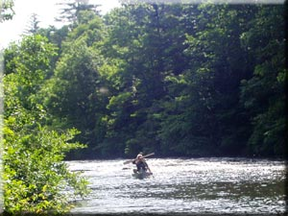- Toccoa/Ocoee River
-
Toccoa/Ocoee River 
Canoeing on the Toccoa River in GeorgiaOrigin Confluence of Canada and Mauldin Creeks in Union County Mouth Hiwassee River in Polk County Source elevation ~ 2,120 ft (646 m) [1] Mouth elevation ~ 750 ft (229 m) [2] The Toccoa River and Ocoee River are actually a single 93-mile-long (150 km)[3] river that flows northwestward through the southern Appalachian Mountains of the southeastern United States. It is called the Toccoa for its 56 miles (90 km) through Georgia,[3] until it reaches the twin cities of McCaysville, Georgia and Copperhill, Tennessee, at the truss bridge which connects Georgia State Route 5 (Blue Ridge Street) with Tennessee State Route 68 and Georgia State Route 60 (Ocoee Street and Toccoa Street). The remainder is called the Ocoee through Tennessee, known for its whitewater rafting, and host to whitewater slalom events during the Centennial 1996 Summer Olympics held primarily in Atlanta, about 100 miles (160 km) to the south.
Contents
Hydrography
The Ocoee River is a tributary of the Hiwassee River, which it joins in Polk County, Tennessee, near the town of Benton. It was an important river for both the Cherokee and Creek tribes.
The Ocoee's flow is controlled by the Tennessee Valley Authority via three dams. Most often the riverbed is nearly dry in the ten-mile stretch used for sporting, the water being diverted through flumes along the side of the mountains. Ocoee #2 dam diverted water, from the middle section of the river, through the flume, until a 2010 rock slide washed out part of the flume, which is currently under repair. The dam was originally built in 1913 by the East Tennessee Power Company to provide hydroelectric power to the new Alcoa company then starting aluminum production operations in Blount County, Tennessee.
The three Ocoee dams are numbered sequentially, with #1 being the farthest downstream and #3 being the farthest upstream. TVA acquired the two original dams (Ocoee #1 and Ocoee #2) in 1939 and started building Ocoee #3 dam in 1940. These dams generate an average of 67,000 kilowatts of electricity in total. The Middle Section contains some 20 named rapids and provides recreational opportunities throughout its eight-month season. One of the largest rapids on the Middle Ocoee, "Hell's Hole," runs right beneath the bridge leading to the power station, with "Powerhouse," a significant ledge with a strong hydraulic, right after it. Upstream (to the southeast), TVA also operates Blue Ridge Dam, which creates Lake Blue Ridge (called Blue Ridge Reservoir by TVA).
The whitewater slalom events during the 1996 Summer Olympics were conducted on a one-mile Olympic whitewater course that is fed by releases of water from Ocoee #3. A 4.5-mile whitewater rafting area farther downstream is fed by water released from Ocoee Dam #2.[4]
Variant names
According to the Geographic Names Information System, the Toccoa/Ocoee River has also been known as: [5]
- Taccoy River
- Tacoy River
See also
- Passiflora incarnata (also known as the Purple passionflower or "Ocoee" in Cherokee)
References
- ^ U.S. Geological Survey. Suches quadrangle, Georgia. 1:24,000. 7.5 Minute Series. Washington D.C.: USGS, 1988.
- ^ U.S. Geological Survey. Benton quadrangle, Tennessee. 1:24,000. 7.5 Minute Series. Washington D.C.: USGS, 1974.
- ^ a b "The National Map". U.S. Geological Survey. http://viewer.nationalmap.gov/viewer/. Retrieved Feb. 16, 2011.
- ^ Ocoee Whitewater, TVA website
- ^ U.S. Geological Survey Geographic Names Information System: Toccoa/Ocoee River
External links
Categories:- Rivers of Georgia (U.S. state)
- Rivers of Tennessee
- 1996 Summer Olympic venues
- Tennessee Valley Authority
- Rivers used for whitewater recreation
- Geography of Polk County, Tennessee
- Geography of Union County, Georgia
- Geography of Fannin County, Georgia
Wikimedia Foundation. 2010.

